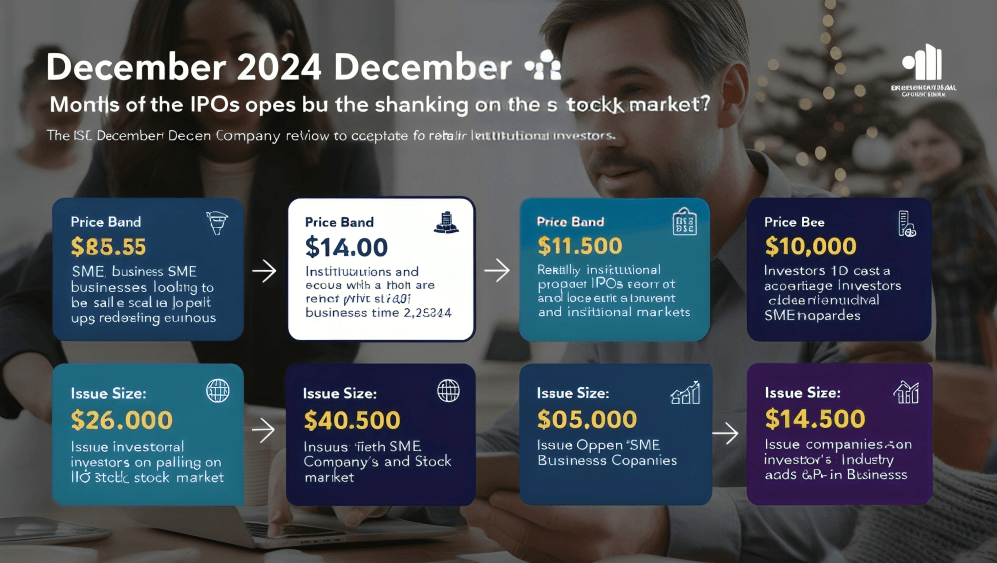IPO guide for small investors
helps navigate the process of purchasing shares in a newly public company. Understanding IPO basics is crucial for small investors to make informed and profitable investment choices.
Table of Contents
ToggleTable of Contents
- Introduction
- What Is an IPO and Why Is It Important for Small Investors?
- Top Challenges Small Investors Face When Investing in IPOs
- How Small Investors Can Apply for IPOs Effectively
- Essential Tips for Evaluating IPOs as a Small Investor
- Affordable Strategies for Small Investors to Succeed in IPOs
- FAQs for Small Investors
- Inspiring Success Stories of Small Investors
- Conclusion: Key Takeaways for Small Investors in IPOs
Introduction
- “IPO guide for small investors” has become increasingly important as more retail participants are joining the stock market, especially in the growing IPO space. Traditionally, initial public offerings (IPOs) were dominated by institutional investors, but recent trends show a rising number of small investors exploring opportunities in these early-stage investments. IPOs like Swiggy, Zepto, and Paytm have captured the interest of many retail investors due to their high-profile launches and the potential for significant returns. These companies, emerging in sectors such as food delivery, e-commerce, and digital payments, have created a new wave of IPO enthusiasm among everyday investors.
IPO guide for small investors As a small investor, the allure of investing in an IPO can be tempting—offering the chance to invest early in a company with growth potential. However, it’s crucial to understand the risks and strategies associated with IPOs before diving in. This IPO guide for small investors will help you navigate this complex process by discussing effective strategies, common pitfalls, and how to evaluate an IPO properly. With a growing number of small investors entering the market, it’s more important than ever to be armed with knowledge. By the end of this guide, you’ll have the tools to approach IPOs with confidence, maximizing your chances for success while minimizing risks.
IPO guide for small investors In this article, we’ll delve into the key factors that every small investor should consider when evaluating an IPO, as well as proven small investor IPO strategies to ensure you’re making the best decisions in this exciting market.
What Is an IPO and Why Is It Important for Small Investors?
IPO guide for small investors An IPO (Initial Public Offering) is the process by which a privately held company offers its shares to the public for the first time. For small investors, understanding what is an IPO for beginners is essential to making informed investment decisions. In simple terms, an IPO allows retail investors to buy shares in companies that are transitioning from private to public ownership. This step provides an incredible opportunity for small investors to participate in the growth of a company early on.
Investing in IPOs offers several key benefits that small investors should not overlook. First and foremost, it presents an opportunity to invest early in growing companies. Many well-known companies, such as Amazon and Google, started as IPOs, offering early investors a chance to see significant returns on their investments. As the company grows and its stock value increases, early investors can benefit from this increase in stock price.
The potential for significant returns is another crucial reason to consider IPO investments. While IPOs carry their risks, investing in the right one can lead to high rewards. Companies that enter the market through an IPO often show substantial growth potential, especially if they are in emerging sectors like technology, fintech, or renewable energy.
IPO guide for small investors Lastly, IPOs allow small investors to diversify their portfolios. By adding stocks from companies in different industries or growth stages, investors can reduce the overall risk of their investment strategy. For instance, fintech IPOs or those in renewable energy offer diversification into rapidly developing industries that might not be accessible through traditional stock purchases.
In recent years, the IPO market has been very active, with several new IPOs offering retail investors the chance to tap into promising sectors. Fintech and renewable energy are just a couple of examples where recent IPOs have provided growth opportunities. For example, investing in the Zomato IPO or the Paytm IPO allowed small investors to gain exposure to the growing Indian digital payments and food-tech market, respectively.
For small investors, understanding why to invest in IPOs can be an effective way to build wealth, especially if you know how to research and evaluate the potential of these offerings.
Top Challenges Small Investors Face When Investing in IPOs
IPO guide for small investors Investing in IPOs can be exciting, but small investors often encounter several challenges that may hinder their success. Understanding these IPO risks for small investors is crucial to navigating the market with confidence. Below are some of the top challenges they face:
- Oversubscription: One of the primary obstacles for small investors is the issue of oversubscription. IPOs with high demand from institutional investors often leave retail investors with a minimal allocation, making it difficult to secure significant shares. This challenge is particularly pronounced in high-profile IPOs, where competition is fierce. Small investors may find themselves left out or with only a small portion of their application fulfilled. Overcoming this requires a strategic approach, such as applying for IPOs across multiple family accounts or focusing on lesser-known, but still promising offerings.
- Lack of Research: Many small investors may lack the tools or resources to conduct thorough research before applying for an IPO. Understanding the company’s financial health, its growth potential, and the risks involved is crucial to making informed decisions. Without adequate research, small investors may make IPO investment mistakes, such as buying into overpriced shares or companies with questionable financials. Tools like prospectuses, stock market analysis reports, and expert reviews can provide valuable insights, but many retail investors may not fully utilize these resources, leaving them vulnerable to poor investment choices.
- Market Volatility: Even after securing shares in an IPO, small investors often face the challenge of market volatility. Post-listing price fluctuations can lead to significant gains or losses, making it difficult for small investors to hold onto their investments without second-guessing. IPO risks for small investors include a company’s stock price dropping after the initial listing due to market conditions, negative news, or investor sentiment. This volatility can cause anxiety among small investors, especially those who are new to the market and unprepared for the unpredictability of stock prices.
IPO guide for small investors In conclusion, while investing in IPOs can be profitable, small investors must be aware of these challenges and take steps to mitigate the risks. By conducting thorough research, applying strategically, and managing expectations around market volatility, small investors can better navigate the complex world of IPOs.
How Small Investors Can Apply for IPOs Effectively
IPO guide for small investors For small investors, applying for an IPO can seem like a daunting task, but with the right approach, it can be an excellent opportunity to build wealth. Here’s a step-by-step IPO application process that will guide you through the essentials of applying for an IPO.
1. Open a Demat and Trading Account
IPO guide for small investors To begin with, you need to have both a Demat account (to hold the shares) and a trading account (to buy and sell the shares). For small investors, it’s crucial to choose beginner-friendly platforms that simplify the process. Popular platforms like Zerodha and Groww are excellent choices, offering low fees, educational resources, and user-friendly interfaces. These platforms make the process of applying for IPOs straightforward, even for first-timers.
2. Understand ASBA (Application Supported by Blocked Amount)
IPO guide for small investors When you apply for an IPO, ASBA is a critical feature that ensures a secure application process. ASBA allows small investors to block the amount required for IPO subscription directly in their bank account, without the funds being debited until the allotment is made. This reduces the risk of fraud and allows you to maintain control over your funds during the application period. By using ASBA, you can also benefit from quick application processing, ensuring that your bid is submitted smoothly.
3. Check Recent IPO Trends
IPO guide for small investors Before applying for any IPO, it’s essential to evaluate the current IPO trends. Recent IPO successes like MapMyIndia and Nykaa have shown how IPOs can yield significant returns when chosen wisely. By studying the success of IPOs like Nykaa, you can understand factors such as the company’s growth potential, sector performance, and market reception. Additionally, many platforms provide real-time data on IPO subscription trends and offer tools to help small investors assess the level of demand and possible over-subscription. This helps you decide whether it’s the right time to apply.
IPO guide for small investors By following these simple steps, small investors can apply for an IPO as a small investor with ease and confidence. The key to success lies in staying informed, using the right tools, and taking advantage of the opportunities that the IPO market presents. With time and patience, your investment in IPOs can be a powerful way to build a diversified portfolio and unlock new financial opportunities.
Essential Tips for Evaluating IPOs as a Small Investor
IPO guide for small investors When venturing into IPO investments, small investors must have a solid strategy for evaluating IPOs. Here are some essential tips that will help guide your decision-making process, ensuring that you make informed choices:
- Check Financial Strength:
IPO guide for small investors One of the first steps in how to analyze an IPO for beginners is to evaluate the financial health of the company. Look for consistent profitability and low debt levels. A company that consistently generates revenue with manageable debt levels is often a safer investment. Small investors should evaluate IPOs by examining key financial ratios such as Return on Equity (ROE) and Debt-to-Equity ratio, which provide insights into the company’s profitability and financial stability.
- Assess Growth Potential:
IPO guide for small investors The next important step in the best ways to evaluate IPOs is identifying the growth potential of the company. Small investors should focus on industries that are experiencing rapid expansion, such as Artificial Intelligence (AI), Electric Vehicles (EVs), or renewable energy. These sectors are not only future-proof but also attract more investor interest, which increases the likelihood of an IPO’s success. Therefore, analyzing a company’s potential in a high-growth industry can give you an edge when deciding which IPO to apply for.
- Review the Promoters’ Track Record:
IPO guide for small investors Another critical factor in how to analyze an IPO for beginners is reviewing the track record of the company’s promoters. A strong leadership team with a history of successful ventures often leads to better outcomes post-IPO. Small investors should research the company founders’ previous successes and how they managed past IPOs or companies. This ensures that the management team has the expertise and credibility to steer the company toward long-term success.
- Study Subscription Numbers:
IPO guide for small investors Finally, the best way to evaluate IPOs involves keeping an eye on the demand for the IPO itself. High subscription numbers particularly from institutional investors can signal strong market confidence. A highly oversubscribed IPO indicates that the market believes in the company’s prospects, which can lead to a strong post-listing performance. Small investors should look at the retail and institutional subscription ratios to gauge whether the IPO is worth pursuing.
By focusing on these four key areas, small investors can improve their chances of making informed, profitable decisions in the IPO market. Always remember to conduct your due diligence and evaluate IPOs based on your investment goals and risk tolerance.
Affordable Strategies for Small Investors to Succeed in IPOs
IPO guide for small investors Investing in an IPO doesn’t always require a large capital investment. For small investors, small-budget IPO strategies can help unlock the potential of IPO markets without breaking the bank. Here are some actionable strategies tailored for small investors looking to invest in IPOs with limited funds:
Focus on Affordable IPOs with Strong Fundamentals
The first step in how to invest in an IPO with limited capital is identifying affordable IPOs with a solid foundation. Many small investors make the mistake of focusing solely on the excitement of big-name IPOs, but there are often better opportunities in lower-priced IPOs. Affordable IPOs can provide an entry point with lower initial costs, while still presenting growth potential. A strong fundamental analysis is key here: investors should evaluate the company’s financial health, growth projections, and market positioning. By investing in IPO stocks with good fundamentals, small investors can mitigate the risk of overpaying for inflated valuations.
Diversify Your IPO Applications
IPO guide for small investors One effective small-budget IPO strategy is to diversify your applications. Many IPOs, particularly those that are highly subscribed, may offer limited shares to retail investors. To increase your chances of allocation, consider applying through multiple family accounts. This approach is particularly useful when applying for IPOs where the demand far exceeds the number of shares available for public allotment. Applying through different accounts can maximize your chances of receiving a larger allotment, giving you more exposure to the IPO market even with limited capital.
Hold for the Long Term
IPO guide for small investors One of the best small investor IPO strategies is to avoid selling your shares immediately after listing. Holding IPO stocks for the long term can often lead to better gains, as companies grow and stabilize in the market. While some small investors may be tempted to sell quickly after an IPO listing to take short-term profits, a more strategic approach is to hold onto your shares for a few months or years. Historically, companies that have shown long-term potential tend to grow beyond their first-day hype, offering higher returns for patient investors. By holding onto your IPO shares, you can allow the stock to appreciate over time and capitalize on long-term growth.
By focusing on affordable IPOs, diversifying applications, and adopting a long-term approach, small investors can successfully navigate the IPO market and achieve solid returns, even on a limited budget. These strategies are not only cost-effective but also essential for mitigating the risks that come with investing in new market listings.
FAQs for Small Investors
Investing in an IPO can seem like a challenging endeavor for small investors, but with the right strategy and approach, it can be a rewarding opportunity. Here are some frequently asked questions that can help small investors navigate the IPO landscape with confidence.
How Can Small Investors Maximize IPO Allotments?
IPO guide for small investors One of the biggest hurdles for small investors in the IPO market is securing an allotment, especially when IPOs are oversubscribed. To maximize IPO allotments, small investors should consider the following strategies:
- Apply Through Multiple Accounts: Many small investors increase their chances of getting an allotment by applying through different family members or friends. This increases the overall number of shares they can receive, especially in high-demand IPOs.
- Invest in IPOs with Lower Subscription Rates: While popular IPOs often have heavy oversubscription, lesser-known IPOs with lower subscription rates might give small investors a better chance of allotment.
- Use the ASBA System: The ASBA (Application Supported by Blocked Amount) system is an essential tool for small investors to apply for IPOs. It allows investors to block the application amount in their bank accounts, reducing the chances of errors in the application process. Using ASBA helps in increasing the chances of IPO allotment.
By leveraging these tactics, small investors can boost their odds of receiving an allotment in a competitive IPO.
Are IPOs Safe for First-Time Investors?
IPO guide for small investors While IPOs can offer significant returns, they also carry inherent risks, especially for first-time investors. However, with the right knowledge and strategies, IPOs can be a valuable part of an investment portfolio.
- Research Is Key: Before applying for any IPO, small investors should thoroughly research the company and its financial health. Read through the prospectus, look at the company’s revenue models, and check for any red flags, such as high levels of debt or unproven business models.
- Consider the Market Conditions: The market’s condition at the time of an IPO can heavily influence the success or failure of an offering. In volatile market conditions, the IPO may experience more price fluctuations, which can make it riskier for first-time investors.
- Risk Tolerance: Small investors should evaluate their risk tolerance before investing in an IPO. IPOs can be volatile in the short term, so if you are risk-averse, it might be wise to avoid highly speculative IPOs.
IPO guide for small investors Overall, IPOs are not inherently safe for first-time investors, but with proper due diligence, they can be a profitable option for those looking to diversify their portfolio.
What Is the Minimum Capital Needed to Invest in an IPO?
IPO guide for small investors The amount of capital required to invest in an IPO varies depending on the price of the shares and the number of shares an investor wants to purchase. Typically, the minimum amount to invest in an IPO can be as low as ₹10,000 to ₹15,000, depending on the face value of the IPO and the share price.
- Minimum Bid Lot: Most IPOs require investors to bid for shares in specific lot sizes. For example, if the minimum bid lot is 10 shares and the share price is ₹100, the minimum capital required would be ₹1,000. Some low-budget IPOs may offer opportunities for small investors to participate with even lower capital.
- Booking Fees: Keep in mind that there may be additional costs like brokerage fees and transaction charges, which can slightly increase the initial capital outlay.
For small investors, it’s important to assess their available funds and determine how much of their portfolio they are willing to allocate toward an IPO investment.
How Do I Research a Company Before Its IPO?
IPO guide for small investors Thorough research is crucial for any investor, particularly for small investors who may not have access to detailed insider information. Here’s how to go about researching a company before investing in its IPO:
- Review the Prospectus: The prospectus (also known as the Red Herring prospectus) is the most reliable source of information. It outlines the company’s business model, financial statements, risk factors, and how the IPO funds will be used.
- Look at Financial Health: Small investors should closely analyze the company’s financial records. Look for trends in revenue, profit margins, and debts. A company with a strong balance sheet and consistent revenue growth is a safer investment.
- Evaluate Market Conditions: Assess the industry the company operates. Is the sector growing, or is it stagnating? Companies in emerging sectors like renewable energy, technology, and AI may have higher growth potential.
- Management and Leadership: Research the company’s leadership team. Strong, experienced management can often lead to better IPO performance, while weak leadership can cause instability.
By conducting a deep dive into the company’s financial health, leadership, and market position, small investors can make informed decisions about which IPOs to pursue.
Which Industries Are Driving the Most IPO Growth?
IPO guide for small investors Several sectors have seen a surge in IPO activity, driven by both market trends and investor demand. The following industries are seeing the most growth in IPO activity:
- Technology and Fintech: With the rise of digital payments, e-commerce, and AI, the technology sector continues to dominate IPO markets. Companies like Paytm and Zomato have already made headlines, and others are following in their footsteps. These companies are attractive for small investors looking to capitalize on the growth of tech and innovation.
- Renewable Energy: As sustainability becomes a central global focus, renewable energy companies are also attracting attention from investors. Solar energy, wind power, and electric vehicles (EVs) are poised to continue growing, making them attractive for small investors looking for long-term opportunities.
- Healthcare and Biotech: Companies in the healthcare and biotech sectors that focus on medical innovations and drug development are seeing high demand. The COVID-19 pandemic has spurred significant interest in healthcare IPOs, especially those with vaccine or treatment pipelines.
By keeping an eye on these growing sectors, small investors can position themselves to take advantage of lucrative IPOs in high-growth industries.
Inspiring Success Stories of Small Investors
IPO guide for small investors Investing in IPOs can seem intimidating for small investors, especially in a market crowded with high-profile companies and financial jargon. However, success stories of retail investors who have made significant gains from IPO investments provide valuable insights and inspiration. “IPO success stories” highlight how informed decision-making and patience are key to unlocking potential returns. These stories are proof that even small investors, with limited capital, can benefit immensely by carefully navigating the IPO landscape. Let’s explore some real-life examples of IPO gains that can guide you in your IPO journey.
1. The Nykaa IPO Success: A Case of Patience and Strategic Investment
IPO guide for small investors in Nykaa, one of India’s leading beauty and wellness e-commerce platforms, went public in 2021, offering a golden opportunity for small investors. The Nykaa IPO was a landmark event, especially because it marked the successful entry of an online beauty retailer into the public market. Small investors who bought shares at the IPO price saw returns soar as Nykaa’s stock price surged post-listing.
IPO guide for small investors For instance, many small investors were able to capitalize on the strong brand recognition and growth prospects of Nykaa. The company’s post-IPO growth was driven by a robust business model, tapping into India’s expanding beauty and wellness sector. Investors who carefully evaluated Nykaa’s fundamentals and growth trajectory were rewarded, with stock prices more than doubling since the IPO.
By investing in IPOs with limited capital, such investors were able to gain considerable returns, proving that even with modest investments, patience, and research can lead to substantial growth. In fact, “IPO success stories” like Nykaa’s show how small investors can benefit from backing emerging market leaders.
2. LIC’s IPO: A Lesson in Long-Term Investment Strategy
IPO guide for small investors The Life Insurance Corporation of India (LIC) made waves with its IPO in 2022, drawing attention from both institutional investors and small investors. LIC’s IPO was the largest public offering in India’s history, which attracted significant media coverage. However, small investors who carefully assessed the company’s valuation and long-term prospects before making an investment decision were able to see substantial gains. The stock price saw initial volatility but eventually recovered as LIC’s brand strength and market presence came into play.
IPO guide for small investors Many small investors with a long-term investment strategy held onto their shares despite the initial dip, showing how patience can pay off. The key takeaway from this real-life example of IPO gains is that understanding an IPO’s market position, business model, and growth outlook can help small investors weather the ups and downs of stock price fluctuations, reaping rewards over time.
3. zomato’s IPO: Leveraging Growth in the Food Delivery Sector
IPO guide for small investors in Zomato’s IPO, launched in mid-2021, was another success story for small investors who took the time to research and understand the potential of the online food delivery industry. Zomato had an established customer base, and its rapid growth during the pandemic caught the attention of many retail investors.
IPO guide for small investors The Zomato IPO was oversubscribed, reflecting strong demand for shares in the food tech sector. Despite some initial challenges post-listing, small investors who evaluated Zomato’s market share and growth potential held on to their investments. The company’s long-term growth prospects, backed by increasing online food delivery adoption, made it an attractive choice for small investors. By making informed decisions, these investors experienced IPO success stories, with their patience being rewarded as Zomato’s value continued to rise.
4. Paytm’s IPO: A Cautionary Tale of Research In IPO guide for small investors
IPO guide for small investors Not every IPO offers immediate success, and Paytm’s IPO in 2021 serves as a reminder to IPO guide for small investors for small investors that careful evaluation is necessary. While Paytm is a household name in India, the company’s IPO faced significant hurdles, with its stock price falling below the issue price in the months after listing. Despite this, there were still small investors who made significant gains by investing in IPOs with long-term horizons, using the opportunity to buy shares at lower prices after the initial dip.
IPO guide for small investors This real-life example of IPO gains demonstrates the importance of researching an IPO thoroughly before investing. Small investors who had a clear understanding of the company’s valuation, market position, and growth strategy made informed decisions. While some investors saw losses in the short term, others capitalized on the lower share prices, holding out for the future growth of Paytm in India’s digital payments ecosystem.
5. The Role of Informed Decision-Making in IPO Investments
IPO guide for small investors The key takeaway from these IPO success stories is the importance of informed decision-making. For small investors, being able to analyze and understand an IPO’s fundamentals such as revenue growth, profitability, debt levels, and industry trends—can lead to better investment outcomes. In particular, focusing on sectors with strong growth potential, like fintech, e-commerce, or renewable energy, can significantly increase the chances of IPO success.
IPO guide for small investors Additionally, small investors should consider the importance of a long-term investment strategy, rather than seeking quick returns. Many real-life examples of IPO gains show that holding shares over the long term, despite initial volatility, can often be the most rewarding approach.
Conclusion about IPO guide for small investors
Small investors can make significant profits from IPOs if they approach their investments with a strategic mindset. By focusing on informed decision-making, researching IPOs thoroughly, and adopting a long-term investment strategy, retail investors can emulate the real-life success stories of others who benefited from IPO gains. Whether it’s the success of Nykaa, the patience shown by LIC investors, or the calculated risk of Zomato, there are valuable lessons in each of these examples that can help small investors succeed in the IPO market.
By staying patient, doing the research, and thinking long-term, small investors can turn IPO opportunities into meaningful financial gains.
Conclusion: Key Takeaways for Small Investors in IPOs
IPO guide for small investors Investing in an IPO can be a game-changer for small investors, but it requires a well-planned strategy and thorough understanding. This beginner’s guide to IPO investing summary will help you navigate through the complexities of this investment opportunity. By focusing on key factors like research, strategic applications, and a long-term perspective, small investors can increase their chances of success in the IPO market.
IPO guide for small investors First and foremost, thorough research is essential when investing in an IPO. As a small investor, you need to understand the financial health of the company, its growth potential, and the overall market conditions. This means looking at the company’s profit margins, debt levels, and recent performance. Analyzing these indicators will give you a clear picture of the IPO risks for small investors. Without this understanding, you could end up making decisions based on market hype rather than solid data, which can lead to losses.
IPO guide for small investors Another key element in IPO investing is strategic applications. Small investors often face the challenge of low IPO allotments due to oversubscription. To maximize your chances of getting shares, consider applying through multiple accounts, such as those of family members. Also, applying only to well-researched IPOs can improve the quality of your portfolio. This way, even if you don’t get the desired allotment, the IPOs you invest in are more likely to yield positive returns.
IPO guide for small investors Long-term thinking is critical in IPO investing. While many small investors may feel the urge to sell their shares as soon as the stock starts trading, it’s often wiser to hold onto them for a longer period. Many successful IPO stories involve investors who stay patient, allowing their investments to grow over time. This long-term mindset helps you weather market volatility, which is common in the early days of an IPO’s trading life.
IPO guide for small investors To wrap up, the small investor IPO checklist includes:
- Conducting thorough research on the IPO’s financials and prospects.
- Strategically applying through multiple accounts for better chances of allotment.
- Holding onto your IPO shares for the long term to maximize returns.
IPO guide for small investors By following these guidelines, small investors can navigate the IPO market with confidence, making informed decisions that align with their investment goals.
Also Read :
Top Upcoming IPOs in December 2024 Investment Opportunities to Watch
Suraksha Diagnostic IPO Key Insights for Investors
Suraksha Diagnostic IPO and Key Dates










